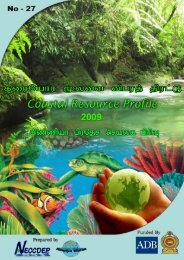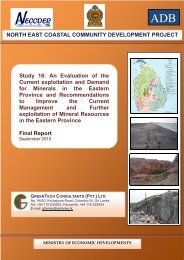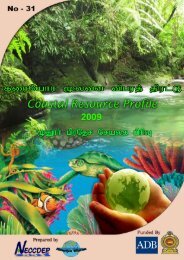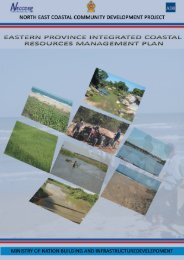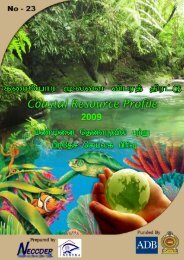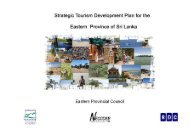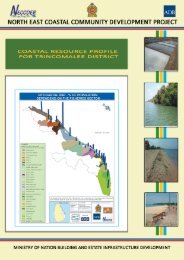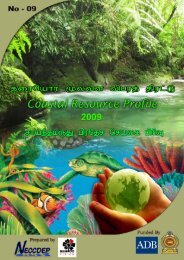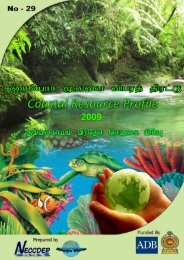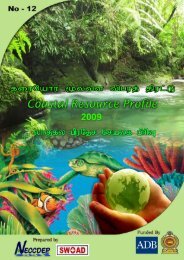Untitled - Neccdep.com
Untitled - Neccdep.com
Untitled - Neccdep.com
Create successful ePaper yourself
Turn your PDF publications into a flip-book with our unique Google optimized e-Paper software.
TRINCOMALEE BAY SPECIAL MANAGEMENT AREA Page | 44<br />
7. Conduct studies to fill critical information gaps necessary to develop and<br />
deliver solutions to environmental problems;<br />
8. Develop the SAM planning framework and implementation mechanisms<br />
to support delivery of the above requirements;<br />
9. Initiate a 3-5 year initial planning cycle to address issues, minimise<br />
negative impacts and enhance positive impacts to achieve the goals<br />
and objectives of the SAM Plan.<br />
10. Monitor and assess SAM delivery.<br />
2. Elements of the process<br />
200. The above guidelines were followed in the planning process. The key elements are<br />
briefly described below.<br />
a. Consultation process carried out by the DSAM CCC<br />
201. Lack of <strong>com</strong>munity participation in the District SMA Committee was an issue at the<br />
beginning of the planning process. Hence strengthening of <strong>com</strong>munity participation from the<br />
DSD level in the DSAM CCC was initiated as the first step in the <strong>com</strong>prehensive SAM Plan.<br />
However, due to lack of time and also the late formation of a CCD <strong>com</strong>pliant Community<br />
Coordinating Committee, it has not been possible to follow the full CCD SAM planning<br />
process. Nevertheless, <strong>com</strong>munities including villagers, NGOs and <strong>com</strong>munity leaders have<br />
been involved to the maximum extent possible and it is expected that the SAM will be subject<br />
to participatory review by District level CCC before consideration by the CCD.<br />
b. Review of studies carried out by other agencies<br />
202. Not all the special studies carried out with the assistance of NECCDEP had been<br />
<strong>com</strong>pleted at time of <strong>com</strong>prehensive SAM planning. Such information as was available from<br />
these special studies at the time of writing of this SAM Plan was used. The studies from<br />
other agencies were also reviewed and incorporated as necessary.<br />
c. Review of NECCDEP IP-NGO resource inventories<br />
203. The resource inventory and preparation of site specific resource profiles were also not<br />
<strong>com</strong>pleted at the time of preparation of this <strong>com</strong>prehensive SAMP. Draft reports were<br />
reviewed and discussions conducted with resource persons and IP-NGOs that conducted the<br />
studies to obtain such information as was available at the time (Ref. 1334, 1350-1355) .<br />
3. Consultation with IP-NGO<br />
204. A one day workshop was held at the Fishers Resting centre at Trin<strong>com</strong>alee with the<br />
IP-NGO who conducted the resource profile studies for Trin<strong>com</strong>alee bay. The list of IP-NGO<br />
and the names of the participants is given in Appendix 7. These IP-NGO staff were engaged<br />
in coastal resources profiling in the TB SAM planning area for more than 5 months and so<br />
developed a good knowledge and understanding of the issues threatening the sustainable<br />
management of the area. These officers also assisted in the field studies. The findings of the<br />
workshop with respect to dependency and threats are listed in Table V.1 below and possible<br />
solutions in Table V.2 below.



